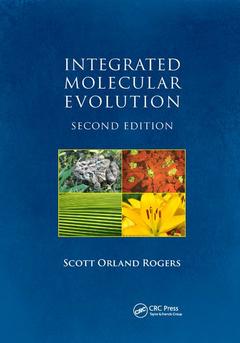Description
Integrated Molecular Evolution (2nd Ed.)
Author: Rogers Scott Orland
Language: English
Subject for Integrated Molecular Evolution:
Keywords
rRNA Genes; Endosymbiotic Events; Genome; DNA Replication; Evolution; DNA Polymerase; Bioinformatics; DNA Virus; Genomics; Group Ii Intron; Molecular biology; Spliceosomal Introns; Molecular evolution; Amino Acids; Ribosome; LSU rRNA; Genome Sizes; Phylogenetic Tree; Obligate Parasites; Plastid Genomes; Hgt; Mitochondrial Genome; Hox Genes; Phylogenetic Network; RNA Polymerase; DNA Ligase; Thylakoid Membrane; Ancient DNA; rRNA Gene Copies; Satellite Virus; NGS Method; Large Ribosomal Subunit
Publication date: 12-2019
· 17.8x25.4 cm · Paperback
Publication date: 08-2016
· 17.8x25.4 cm · Hardback
Description
/li>Contents
/li>Biography
/li>
Evolutionary biology has increasingly relied upon tools developed in molecular biology that allow for the structure and function of macromolecules to be used as data for exploring the patterns and processes of evolutionary change. Integrated Molecular Evolution, Second Edition is a textbook intended to expansively and comprehensive review evolutionary studies now routinely using molecular data. This new edition has been thoroughly updated and expanded, and provides a basic summary of evolutionary biology as well as a review of current phylogenetics and phylogenomics.
Reflecting a burgeoning pedagogical landscape, this new edition includes nearly double the number of chapters, including a new section on molecular and bioinformatic methods. Dedicated chapters were added on:
- Evolution of the genetic code
- Mendelian genetics and population genetics
- Natural selection
- Horizontal gene transfers
- Animal development and plant development
- Cancer
- Extraction of biological molecules
- Analytical methods
- Sequencing methods and sequencing analyses
- Omics
- Phylogenetics and phylogenetic networks
- Protein trafficking
- Human genomics
More than 400 illustrations appear in this edition, doubling the number included in the first edition, and over 100 of these diagrams are now in color.
The second edition combines and integrates extensive summaries of genetics and evolutionary biology in a manner that is accessible for students at either the graduate or undergraduate level. It also provides both the basic foundations of molecular evolution, such as the structure and function of DNA, RNA and proteins, as well as more advanced chapters reviewing analytical techniques for obtaining sequences, and interpreting and archiving molecular and genomic data.
LIFE AND EVOLUTION. Definitions of Life. Earth and Evolution. BIOMOLECULES. DNA, RNA, and Proteins. The Central Dogma and Beyond. Ribosomes and Ribosomal RNA. Structure of the Genetic Code. DNA Replication. DNA Segregation. GENETICS. Mendelian and Non-Mendelian Characters. Population Genetics. Alleles through Time. Changes to DNA. Infectious Changes to DNA: Viruses, Plasmids, Transposons, and Introns. MULTICELLULARITY. Multigene Families. Horizontal Gene Transfer. Development: Part I—Cooperation Among Cells. Development: Part II—Plants. Cancer. MOLECULAR BIOLOGY AND BIOINFORMATIC METHODS. Extraction and Quantification of Biological Molecules. Recombinant DNA and Characterization of Biological Molecules. Sequencing and Alignment Methods. OMICS: Part I. OMICS: Part II. Species Concepts and Phylogenetics. Phylogenetic Networks and Reticulate Evolution. Phylogenomics and Comparative Genomics. GENOMES. RNA Viruses. DNA Viruses. Bacteria and Archaea. Mutualists and Pathogens. Endosymbionts and Organelles. Protein Trafficking. Eukaryotic Genomes. Human Genome.
Scott Orland Rogers is a professor of molecular biology and evolution at Bowling Green State University, Bowling Green, Ohio. He received his PhD in plant molecular biology from the University of Washington, Seattle. He was an assistant professor and associate professor at the State University of New York College of Environmental Science and Forestry before moving to BGSU. He has taught courses in biology, botany, cell physiology, molecular biology, molecular genetics, bioinformatics, and molecular evolution. Research in his lab includes studies of microbes and nucleic acids preserved in ice, life in extreme environments, group I introns, molecular microbial phylogenetics, microbial metagenomics/metatranscriptomics, ancient DNA, and plant development.
These books may interest you

PhylogenomicsA Primer 103.03 €



